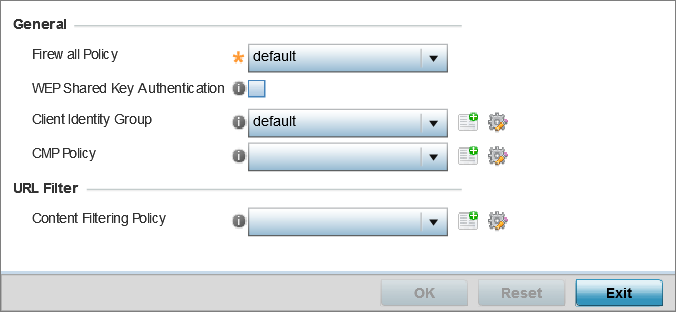Defining Profile Security Settings
A profile can make use of existing firewall, wireless client role, and WIPS policies
and apply them to the profile‘s configuration. This affords each profile a truly
unique combination of data protection policies for best meeting the data protection
requirements of the profile it supports. However, as deployment requirements arise,
an individual device may need some or all of its general security configuration
overridden from the profile‘s settings.
To configure a profile‘s security settings and overrides:
-
Select from the web UI.
-
Expand the Security menu and select
Settings.
Profile Security - Settings screen
-
Select a firewall policy from the Firewall Policy
drop-down menu. All devices using this profile must meet the requirements of the
firewall policy to access the network. A firewall is a mechanism enforcing
access control, and is considered a first line of defense in protecting
proprietary information within the network. The means by which this is
accomplished varies, but in principle, a firewall can be thought of as
mechanisms both blocking and permitting data traffic within the network. If an
existing Firewall policy does not meet your requirements, select the Create icon
to create a new firewall policy that can be applied to this profile. An existing
policy can also be selected and edited as needed using the Edit icon.
-
Select the WEP Shared Key
Authentication option to require profile supported devices to
use a WEP key to access the network using this profile. The access point, other
proprietary routers, and our clients use the key algorithm to convert an ASCII
string to the same hexadecimal number. Clients without our adapters need to use
WEP keys manually configured as hexadecimal numbers. This option is disabled by
default.
-
Client Identity is a set of
unique fingerprints used to identify a class of devices. This information is
used to configure permissions and access rules for devices classes in the
network. A client identity group is a collection of client identities that
identify devices and applies specific permissions and restrictions on these
devices. From the drop-down menu select the Client Identity
Group to use with this device profile. For more information, see
Device Fingerprinting.
-
Use the CMP Policy drop-down
menu to apply a CMP policy. CMP (Certificate Management
Protocol) is an Internet protocol to obtain and manage digital
certificates in a PKI (Public
Key Infrastructure) network. A CA (Certificate Authority)
issues the certificates using the defined CMP.
-
Use the URL Filter
drop-down menu to select or override the URL Filter configuration applied to
this virtual interface.
URL filtering is used to
restrict access to resources on the internet.
-
Click OK to save the
changes or overrides.
Click Reset to revert
to the last saved configuration.
